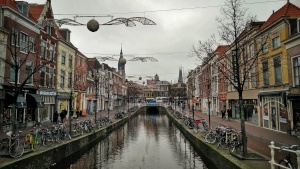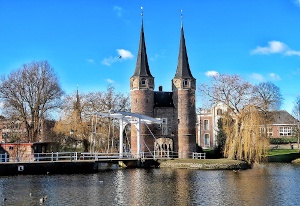July 25, 2019
Since Gouda we have been on the move, visiting interesting small towns. From Alphen on the Rhine we cruised to Oost-Graftdijk, which has a harbor whose entrance is barely wider than our boat. There was a friendly harbor master on duty that day. This marina is organized as a club so members have to contribute time. Managing the harbor is one of the things they do. He told us about boating in Germany. There is now a license requirement, so I will spend the next 10 days finding out how I can get the International Certificate of Competence, finally finding someone in Holland who can give me the practical test. Of this test the instructor said that if you have been boating for 10 years and have not divorced or be involved with lawyers then you will pass. It mainly consists of boat handling in tight quarters. I am good at that, the occasional scratch notwithstanding. The written test concerns the rules of the waterway, signs and signals, not too hard if you study enough.
Next was Haarlem again, there so our guest could tour the town and make it to Schipol Airport easily for his return flight.

Haarlem is home to the Franz Hals museum. Hals (1582 – 1666) was a Dutch Golden Age painter noted for his loose style, characterized by visible brush strokes, previously considered a fault. He painted in layers as was the common practice, although you might think he was more spontaneous given the visibility of his brush strokes. Mostly he painted portraits, and is best known for his group portrayals. When he began his career the market had disappeared for religious themes, deemed as being too Catholic, leaving portraiture as the major option for an artist wanting to make a living.
In the main plaza, aside from the church with its magnificent organ, there are the usual restaurants with outdoor seating, and a fish truck run by a friendly woman. The truck has been in the plaza for over 40 years. She took over from her father. There is herring, eaten raw after being freshly cleaned, as well as deep fried fish, smoked mackerel and Lekkerbeck, which is cod and served everywhere. Herring, she explained, is seldom served in restaurants, as it must be freshly cleaned. Other such trucks offer fries, which the Dutch do very well.
From Haarlem we went to to Pannekoek Eiland, Pancake Island, on a lake just outside Akersloot. The mooring is free with room perhaps for 6 boats. A walk around the island takes five minutes at the most. In front of us are two large boats and behind a nicely restored barge. It is a pretty spot. Unfortunately it was stormy the entire night. Conditions worsened around 0500 the next morning, forcing the boat against the dock thus squeezing the air out of two fenders. We were unable to sleep after that hour due to the howling wind and the motion of the boat.

We left for Alkmaar after the wind died down. This is a repeat visit to collect visitors. The following morning we took them through the lovely and winding canal to de Strook. This tiny village has some of the most beautiful gardens and charming houses we have encountered in our two journeys through the inland waterways of the country. Unfortunately I have no photos to share.

The next day we went north to Den Helder via the longer of the two routes, and more intersting. Once there, getting to the Jachthaven Willemsoord meant going through a lock connecting the fresh water canal with the salt water on the other side. This lead to difficulties in tying the boat within the lock as there is a strong current, which is not common in locks. When Peg tied to the middle cleat the stern popped way out towards the middle. I was unable to bring it back in. Next to us was a large barge, whose pilot and assistant were there to help. He told me about the current and said the way to get into that lock is to secure the stern first.

Den Helder has a naval museum that includes a Dutch submarine visit and a humorous sketch, that is judging by the audience reaction. It was entirely in Dutch so we only had hints of content from the context.



After our guests left I traced down a slow leak, which was coming from a fresh water pump (called an impeller) that sits on the engine. I have to get someone to replace the seal, as I am uncertain about how it is constructed. It is minor so no reason to delay our departure the next day.
July 26th broke to strong winds, about 50 kph/30mph coming from the east. We debated going into the Wattenmeer (Wadden Sea) to get to Medemblik. This is faster than the canal route, part of which we have already used in getting to Den Helden. There are no bridges and just one lock by the open route so it is faster than the canal and cooler, too, because of the breezes you get in open water. By 1300 the wind had abated some so we headed into the main area of the harbor where yesterday a sea lion approached the boat, taking a look at us as if to wonder if we had any goodies. Then we headed into the sea.
It started calmly enough as we headed northeast out of the harbor. The well marked channel takes you well off shore, as there the water can be shallow. We used an app on our phone as none of our plastic coated paper charts covered the area. The app worked quite well as it kept us on course, at least after I learned not to put the phone in the sun where it overheated and shut off. The wind kept us quite cool the entire time but the phone was not in the breeze, having to stay in the shade.
The waves mounted after a while. We began to pound. This means we were able to cut through the waves and not be heaved from side to side, which is less comfortable, but each time the bow would hit a wave it smacks into it. At just 2 or 3 feet (2/3 to 1 meter), this is not terribly uncomfortable but a flat sea is nicer. The bikes got some spray, and we had to close the portholes (windows) on the bow to keep salt spray out of the front cabin. In less than an hour the waters calmed, for a while only, as it turned out.
We were not alone in the wide expanse. Many sail boats joined the action, some motor sailing despite the adequate wind. The only power boat we saw in the 2.5 hours to Den Oever was a tug, who plowed up fast one meter waves. Seeing them coming, I shied away then turned back to meet the wave at a 45. We rocked, a drawer sprang open in the galley, but otherwise there was no problem. We store everything that can fall every time we depart, part of our coastal cruise training via the US Power Squadron in the early 1990’s. They offer excellent courses for very modest fees.
There is a lock in Den Oever. It allows you through the mighty dike that keeps the North Sea, of which the Wattenmeer is just an extension, providing little protection for the country, thus the need to build the dike. In 1953 the North Sea rose, flooding much of the Nederlands (‘Neder’ means ‘low’), killing thousands and causing billions in property damage. This lead to the extensive dike system they have today. Levels are constantly monitored and controlled by central computers. Hundreds of thousands of structures are just a few inches above the waterline of canals, some are below, as we have seen the tops of roofs go by as we sail.
Easy lock, built especially for pleasure craft. Now we are in the Ijsselmeer, in fresh water again, heading in a southerly direction. The wind was still strong from the east, so one can anticipate a beam sea. This means that the waves hit you from the side, causing boats like ours to roll. Sailboats have a deeper keel so they are less subject to rolling, and to make progress while under sail they tack back and forth anyway. After a while we had to do the same, moving from 45 degrees to the south east to 45 to the south west. This way you can cut through the waves and reduce the rolling. You have to travel farther so it takes more time to complete your journey, but the ship’s passengers are more comfortable. Our app kept us on course as we weaved our way through a long spell without buoyage to guide us. We could see land the entire time, but you have to know where you are headed and not just hug the shore close enough to identify your destination.
There are many boats in Medemblik and plenty of moorings, so when we arrived at 1800 we were able to find a spot. It was hot, around 30c, 86f but cooled off considerably by 2300. The next morning we got on our bikes, passing through the downtown shopping area just around the corner. There were scads of bicyclers having coffee and applegebak (apple pie) and shoppers everywhere, as is common on Saturdays. Not far from there we came to the windmill. It dates from circa 1700. It has been moved three times. They still make flour, which they sell in the shop and to several restaurants. It is staffed by volunteers. You see the main gears for grinding during your visit. I was struck by how the basic technology is so similar to automotive engines and transmissions. The sails (the engine’s pistons) turns a crankshaft. To turn the grinding stones you engage a gear composed of cogs, just like in a manual transmission.
The town has a castle dating from around 1200. It has been through at least two major renovations so the original look is not there anymore. Just two residential wings, two square towers and one round tower remain. Muiden Castle was built by the same man, a Count Floris. “The name Radboud has been derived from the popular assumption that the castle was built on the place where in the 8th century a castle from the Frisian king Radboud had been standing.” http://www.castles.nl/radboud-castle Several of the locals we’ve talked to refer to this area as West Friesland, although today it is part of North Holland. Friesland is on the other side of the Ijsselmeer, in the northeast part of the country, bordering Germany. It is from there where we plan to start next year’s excursions into the northern part of that country.
























